A War, a Game, a Simulation
Reflections on UKRAiNATV’s Documentation of Transmediale 2023 in Berlin
By Giulia Rossana Timis
1. Fantastic Little Splash (Lera Malchenko and Oleksandr Hants)
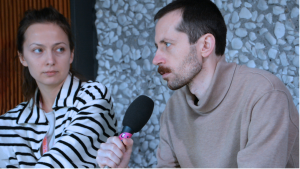
Lera Malchenko and Oleksandr Hants during our interview at Transmediale 36
UKRAiNATV’s experience at the 2023 Transmediale festival in Berlin started on February 2nd. Our first interview was conducted by Roman Dziadkiewicz with two members of the art collective fantastic little splash, Ukrainian artist Lera Malchenko and artist-director Oleksandr Hants. They started their project ‘see also’ in 2022, during a two month-residency at Transmediale/, which was exhibited at the festival’s 36th edition.
Quoting Lera Malchenko, this particular project is «a set of compressed images and feelings or, in other words, some kind of interactive archive of war images». Some themes that will be recurrent during all the interviews with different kinds of artists and researchers are game, war, and simulation. In the context of cyberwar, as one of the levels of the Russian invasion of Ukraine, their project ‘see also’ has a game simulacrum: it was developed in Unity, a game engine, but as Hants says: «We didn’t want to create a real game, because the topic is really sensitive (…). We decided that this interactive way of presenting the project could be really helpful to speak about this difficult topic. This is why we decided to use a game engine, but we didn’t perceive it as a game».
Another interesting aspect while talking with different artists, is Ukraine’s relationship with humour. This is a topic that came out on different occasions, and it finds a place in the context of war when we start to talk about the role that memes are playing in it. Hants states that thanks to the particular humour that Ukrainian people share in their culture, memes have become a weapon in their own hands: «I think this war is a lot about entertainment (…) like a TV show, with all these reviews of weapons, reviews of successful attacks (…). This is one of the aspects that makes this war kind of special, in terms of media». The other side of the coin, remembers Malchenko, is «sometimes I hear it from our soldiers, that all these memes are a really great way to fight, to mobilize. But it can also create this huge gap from reality, especially in war zones». On the other hand it’s also a «live war, constantly ringing in your pocket. You can’t break out of it», says Hants. This is something that also people around my close circle of friends, and from the studio, share: the inability to escape the war even if you’re geographically far away from it, and the sense of guilt that follows the second after this thought was worded.
An example of virtual terrorism against Russian colonial groups online, comes from their project ‘forward, upward, in all directions’ (2018). During the exploration of different VRChat maps, the two artists got themselves across the Russian ‘Slavic World’ map. In this VR world, Russian players were wearing highly militarized skins and recreating an environment of hierarchy and segregation. The disturbance, performed by some Ukrainian players, consisted of entering the map with highly particularized skins, which resulted in the crash of the world and the expulsion of all the players from that map.2.Svitlana Matviyenko
2. Svitlana Matviyenko Interviewed by Roman Dziadkiewicz
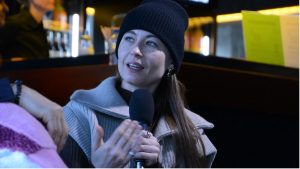
A second talk, another point of view, with new interesting perspectives. The guest is Svitlana Matviyenko, a Ukrainian scholar, professor and media theorist. After living and teaching in Canada for some years, she’s now based in Western Europe, due to the outbreak of the war in Ukraine. The conversation starts with the resumption of The Imaginary App from 2014, edited in collaboration with Paul D. Miller for MIT Press. Matviyenko has a background in cybernetics, and this book is an investigation of apps. In the present context of war, the connection with gaming culture – a theme that is recurrent during these talks – in a world where everything seems accessible at our fingertips, shapes our perception of it. In regards to this connection, Matviyenko states: «Everywhere, behind playfulness, there is something military. (…) That is very symptomatic for modern culture and modern technology, that those two realms, they converge.»
Again the theme of game culture’s connection to the war comes up, in a climate of hyper-cybered war circulating on different platforms, TikTok over the others. Quoting Matviyenko: «The easiness of using those tools for playing (…) has a very important role in how the media landscape developed during this war. One of the key examples here is of course TikTok videos of Russian soldiers». There is even a brand new way of documenting the war, she explains: «People document genocide on TikTok. It’s a ridiculous combination,» unimaginable ten years ago. Continuing the discussion about platforms, and recalling Shoshana Zuboff’s book Surveillance Capitalism, Matviyenko starts a reflection on the current democratic realm, and the new forms of surveillance: «I would rather see new forms of securitization, new forms of surveillance and even new forms of mobilization. (…) Which end up in certain surveillance and securitization.» The circle closes with no space for a bright future, apparently. The urge is to move away from corporate platforms, due to a new type of user behaviour: «We are noticing a new type of user behaviour, without allegiances (…) and commitment. (…) I think the platforms may adapt, or we will use them in a different way. (…) Now we are in an interesting moment of breaking allegiances, and this whole movement from Twitter – for example – to new platforms, is quite symptomatic in this sense. Because at the same time, it is a symptom of breaking these allegiances and a symptom of this still present desire for commitment to better platforms.»
The conversation then switches to Armed Democracy, the title of the 2022 Warsaw Biennale, and Matviyenko’s diaries from southern Ukraine, where her parents live, ‘Dispatches from the Place of Imminence,’ which she started in February 2022 (published by the Institute of Network Cultures). Svitlana: «My whole agenda and intention in this writing is to demonstrate how disarmed and confused the subject of war is. (…) The subject who, with all her theories, feels disarmed». Those diaries are in fact a disclosure of the author’s vulnerability, and not only hers. A lot of people in Ukraine started diarising the war. .» And continues: «What does it mean to wait for the war? (…) In the beginning, it was very much about my diary, and then half a year later I discovered that so many people in Ukraine were writing diaries. (…) And now I am theorizing this kind of movement of diarising a war». She then deepens into it, stating that intuitively a big group of people is developing a way to deal with this situation through the form of a diary. She concludes: «It demonstrates the symptoms that we addressed at the very beginning: it’s not about feeling armed, it’s about feeling disarmed».
3. Noura Tafeche
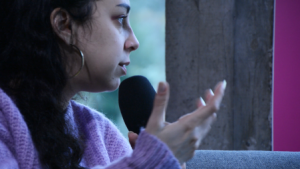
In dialogue with Noura Tafeche during Transmediale 36
We continued with the recording of an interview that I conducted with visual artist and researcher Noura Tafeche. This dialogue was held hybrid, meaning that we actively switched between two languages: the colonial passe-partout English, and our common mother-tongue, Italian. It happened many times at UKRAiNATV that talks were held partly in Ukrainian, Polish and English, so we liked the idea to maintain this format for this interview, and it perfectly matched the topics we explored. A sentence from the artist’s statement on her website synthesizes this concept: “Dove manca la parola manca la realtà” (transl. “Where it lacks the word it lacks reality”). We don’t deny the comforts of using a more universal language, but we dream of a moment in time when every language is. And why English in the first place?
During the conversation we investigate the concept of neologism, like in Tafeche’s work Prove di Enciclopedia Olfattiva: Neologismi per la Parosmia (2021 – ongoing) and Onomaturgia prima della Quiete (2022). Noura: «Whenever some words are lacking I feel like I’m disconnected from my own reality». In this specific case, Tafeche is referring to her loss of sense of smell after experiencing Covid-19. This short circuit created by the medical condition of parosmia applies to the language in general. Smell is one of the five senses with which we perceive the world, we shape it and we report it to others. Likewise, language is not just a container, but a tool that helps us connect with others and influences the perception of our surroundings. She continued: «The importance of mixing and hybridizing idioms is just as central (…) as the importance of extending the concept of multilingualism, which, however, should not be in favor of one. I believe that it is not enough to delegate (…) to one language the structuring of our thinking. Getting more and more inside different languages (…) is essential for the processes of decolonization that are often talked about».
The supremacy of controversial and ambiguous aesthetics is what fuels the majority of the research right now. With an archive of more or less 32.000 images and videos, Tafeche’s twin projects 75 Tbps of (✿◠ω◠) ︻╦╤─ and The Kawayoku Inception (2020 – ongoing) dig deep into this controversy. 75 Tbps of (✿◠ω◠) ︻╦╤─ (explained: 75 terabytes of cute-violence) was born in 2020 during a workshop hosted by the Freeport Institute, a spin-off project created by Bani Brusadin, one of the curators of The Influencers festival, in collaboration with the Clusterduck collective. Using Tafeche’s words, with this project she wants to “give shape to the phenomenon of digital militarism, online platforms’ unconventional propaganda strategies, entangled with cuteness and hypersexualization.” (taken from her website).
At the very beginning of her research, Noura entered by chance an online pro-guns community and found out about the existence of customized weapons, known by the name of kalashnikitty. «This hybridization of imagery inside internet subcultures expanded my perception, and pushed me to dig more and more into the domain of how ambiguous this aesthetic was». While discussing with Noura Tafeche about these hypersexualized young girls, which were basically promoting enrollment in their government’s military service on TikTok, the only word I could think of was: cringe. That same word came to my mind back when I first discovered the artist’s work and started watching the sickening content that filled the feeds of these influencers.
Similarly, the Japanese kawaii (transl. cute) pop culture makes them be perceived as unharmful, but it’s precisely their intention: they’re like wolves in sheep’s clothing; the worst part is that they’re really successful in their aim. We are all either so anesthetized by these images, or yet so repulsed by them, that we prefer to look away. I would rather not, but as Tafeche phrased during the interview, all this content started to pollute her mind. Being exposed to all the sludge of the internet is, slowly, poisoning. She points out how these dances and performative acts on TikTok create a routine that builds collective rituals on social networks. By imitation, users replicate what they see, and it’s precisely what this mil talk (military talk) leverages, one above the other, including the US army. Whether this practice of unconventional recruiting is intentional or not is still not clear, but the effects are.
Then UKRAiNATV member Roman Dziadkiewicz joined us, and the conversation ended with some reflections on the colour pink. During Noura Tafeche’s workshop, Baker-Miller Pink (or Drunk-Tank Pink) was introduced, a specific pink tone that should temporarily reduce violent behavior in observed subjects. Concerning the research there was no unanimous conclusion, but what was interesting was the bias we had toward this specific colour, and how pink is often used in contrast to the perception we have of it. The names of the Code Pink and the Clown Army (Clandestine Insurgent Rebel Clown Army) were brought up, as examples of activist groups that used this – mostly – harmless perceived colour, as a weapon. In this specific case, I believe, for a good cause.
4. McKenzie Wark
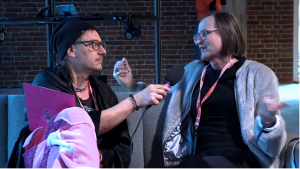
McKenzie Wark in dialogue with Roman Dziadkiewicz
The Synthetic Images panel was held on the 3rd day of the Transmediale/ festival. It was a dialogue between the artist Bahar Noorizadeh and the writer McKenzie Wark, moderated by Robert Gerard Pietrusko. After the talk, we invited Wark to have a short interview with us. The conversation started with the colour pink, which was brought up during the conversation with Bahar Noorizadeh, along with the question: where’s the pink (political) party? There are definitely pink parties, but not on the other’s behalf for now.
It just so happens that pink is also UKRAiNATV’s main symbol, together with acid green. After this warm-up, the flux of consciousness expanded. Pink is also the colour of Wark’s new book cover, Raving (Duke University Press Books, 2022), which discusses the underground queer and trans rave scene in New York. Most of them are occupied places, holding illegal rave parties (but as Wark reminds us, you still have to pay to get in).
However, McKenzie states, it’s a good way to get off your phone for a few hours, in a reparative space. «Maybe that’s a space where we can withdraw a little bit from constant surveillance, (…) even surveillance of ourselves». As in Hakim Bey’s T.A.Z.: Temporary Autonomous Zone, these occupied places are not forever. The rave scene is migrant and changing, but always active. And in a certain way, raves are giving power to people to not think just about war.
5. Asia Bazdyrieva (Geocinema)
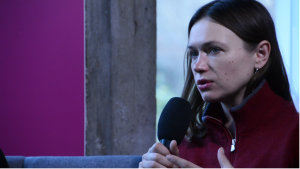
Asia Bazdyrieva from Geocinema at Transmediale 36
Last but not least we recorded a conversation with art historian Asia Bazdyrieva. She was a Transmediale 2022/23 artist-in-residence for six months and part of the project ‘Geocinema’, together with the filmmaker Solveig Suess. This project collected audiovisual data by connecting to planetary-scale sensory networks such as cell phones, surveillance cameras, satellites, and geo-sensors. On the website they write: “Here, the representation of earth is the sum of a decentralized editing process with its image anything but whole.”
Asia Bazdyrieva spoke about her research and the initial proposition to continue her work on the topics covered in her e-flux Journal essay No milk no love in which she talks about the «particular situation of Ukraine that has been rendered into a territory through socio-technically imaginaries over the past few hundred years, through cartographic processes and expansion on the European side, and then also with the expansion of a longer project of modernity.» In regard to the differences in the idea of modernity pursued by Europe on one side, and Soviet Union on the other, she reminds us that the «Soviet Union is the actualization of radical utopian dreams, developed in Western Europe.» She then directs the talk on how Ukraine was always perceived as a country full of resources, which made it a desirable target for Putin’s imperialist project. Behind all the speculation and excuses, she says that we are trying hard not to see clearly what this war is also about: «The current war is part of this logic of Ukraine being this place with a lot of resources, and of course, humans matter, but they’re – at the same time – part of this material transaction». Continuing on this topic, she calls the infrastructures (e.g. Nord Stream II) forms of media, because «by looking at them, we can interpret space and time in a particular way».
Roman Dziadkiewicz asked her about the colonial attitudes of the Soviet Union—and what remained of it. Asia Bazdyrieva: «What’s particularly interesting in the Soviet current reality, and I think it’s very much not present in the western discourse, it’s how exactly exploitation was happening. For example, in Europe there are many conversations about the production of racialized bodies, in regard to people of colour and other marginalized groups, and how they are used through specific forms of exploitation. This becomes really unclear in the Soviet Union, where chauvinism and the production of racialized bodies based on ethnic backgrounds, like people from Central Asia or indigenous people in Siberia was not the only form of segregation.» The Soviet Union claimed that they removed the bourgeoisie, but the stratification of society was happening most of the time not through an ethnic parameter. They designed a special category for that, the enemies of the nation. «I’m still really fascinated to see that for example in Siberia, the discovery of geological deposits coincides with the establishment of gulags. (…) those people were used as a free labour force (…) to support the economy. The entire economy was based on slave labour in many ways, whether officially or through propaganda» she concludes.
Talking about post-colonial theories: the question that seemed left behind us in the dark era of World War II is how the concept of the nation in Ukraine emerged as an outcome of the protests going on in 2013/14, when people were uniting to protect human rights and answer to state violence, instead of seeing Maidan as the expression of a nationalist drive. «It is very tempting to just talk about rocks, and geology (…) but the ultimate goal it’s not the rocks as such, but what happens when people are counted as rocks.» Bazdyrieva then also recalls Svitlana Matviyenko’s opening lecture, quoting the sentence how “Ukrainian corruption fed European economy for decades”.
In her final remark on Geocinema, she talked about the definition of geocinema, given by Jussi Parikka, the media theorist and co-curator of the 2023 Transmediale edition: “Over the past few decades the sensing and imaging techniques, (…) produced a new type of visuality. (…) It’s important to say that it’s not about images as such, but rather about what’s being calculated at this very moment”. She says: «It’s not about the picture but about the data that’s extracted at this moment. (…) With Geocinema, the idea is much more about how it’s seen rather than what it’s seen».
With our trip to Transmediale, we started collecting. What UKRAiNATV – as a group – did in the last couple of months, is to create a network, and expand that web so the people involved could have a stage. What it gave to me, and most of the artists working in the studio is a voice and acknowledgment of that voice. The latest example is what we organized on the 24th of February, after one year of war in Ukraine. It was a 24-hour event, solely possible because of the different artists that performed live and via streaming in the studio. All the materials that we are storing will be part of a collective archive, which is not static, but in constant evolution. Our dream is that the energy we are channeling will be inspirational for every person who needs it. UKRAiNATV is creating links between people, platforms, bodies, and experiences. We just started our new season III, and waiting to publish all the interviews you read about above, we leave you the link to the #EFIR 42, which contains the talk with McKenzie Wark. A big thank you to all the people who are keeping this idea alive, and to the ones who remember.
Sources
- https://transmediale.de/en
- https://fantasticlittlesplash.com/
- https://fantasticlittlesplash.com/forward-upward-in-all-directions
- https://fantasticlittlesplash.com/see-also
- https://archive.transmediale.de/participant/svitlana-matviyenko
- https://mitpress.mit.edu/9780262027489/the-imaginary-app/
- https://biennalewarszawa.pl/armed-democracy/
- https://networkcultures.org/blog/2022/02/25/dispatches-from-the-place-of-imminence-by-svitlana-matviyenko/
- https://www.dukeupress.edu/raving
- https://baharnoorizadeh.com/
- https://nouratafeche.com/
- https://theinfluencers.org/
- https://freeport.institute/
- https://theinfluencers.org/en/bani-brusadin
- http://clusterduck.space/
- https://geocinema.network/
- https://www.digitalearth.art/asia-bazdyrieva
- https://jussiparikka.net/about/
- https://2023.transmediale.de/en/event/marshall-mcluhan-lecture-2023


